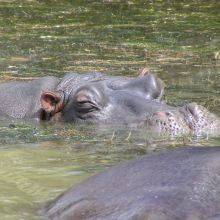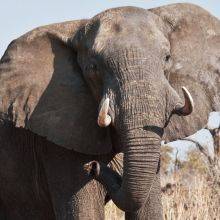When Is the Best Time
Kruger is a dream destination for wildlife spotting. It doesn't matter when you visit the Kruger it is always spectacular even in the rain. The south has a higher density of the Big Five, wild dogs, and cheetahs than the northern part.
Therefore, more guided hikes let by rangers are offered in the north. Nature is truly beautiful; the baobabs are impressive. Birding is also excellent, especially in the wet season when migratory birds can be spotted as well. Kruger is a popular wildlife park with almost one million visitors annually. If lions or a leopard are spotted you may end up in a crowd of cars.
Game Viewing and Weather Calendar
Kruger is a year-round destination; every month is different and worth visiting. The best time for wildlife viewing in Kruger National Park is in the southern winter, from May to September. The game concentration at waterholes is high, vegetation is low, and animals are easier to spot.
December
During summer, it is hot and humid, therefore, occasionally, thunderstorms in the afternoon. It's the peak breeding season of the impalas and zebras. There is plenty of water for the game available inside the entire KNP; therefore, the game is spread throughout the park more difficult to spot. Due to the heat almost none game activity; all are resting usually looking for shade.´.
January
It's the peak of the rainy season; therefore, the landscape is colourful. The marula trees begin fruiting, which is a feast for primates. Due to the high amount of rainfall, water and grazing are plentiful. The game is widespread in KNP and more difficult to spot.
February
It is still hot and humid. The vegetation is dense and colourful still many summer flowers are in bloom. Due to the nutritious plants, game is in very good conditions and still spread around the entire KNP. It's the waterbuck breeding season.
March
It is the end of the summer but still hot and rainy. The vegetation is high, and game is still difficult to spot. It's the main breeding season of kudus and buffalo.
April
Temperatures drop, and occasional showers occur. The rutting season for wildebeest, impala, and warthog starts which causes an aggressive courtship.
May
It's autumn now, frequently windy, and trees begin dropping their leaves. Also, in Kruger occurs a wildlife migration. They are moving to warmer areas because night temps are cold. Elephants are moving to the northern part of Kruger.
June
The colder and dry season starts. Days are pleasant, and nights are cold. The grass is receding, the bush thins out, and spotting wildlife becomes easier. The game is concentrating on the eastern rich feeding grounds.
July
During the night, almost freezing temps; however, day temperatures are around 20°C. Days are sunny and clear. The mopane changes the colour into yellow and orange, what we actually call fall foliage, usually in autumn. The game conditions worsen due to the dry season and less food. However, spotting wildlife becomes excellent, especially in the open grassland and south of Skukuza.
August
Almost the end of the dry winter. The bush and grass are dry, water shortage; therefore, game conditions are poor. Now it's a good time for predators to kill weaker animals. Wildlife watching is excellent because they gather at the last remaining waterholes.
September
The first rains are a sign for the upcoming spring. Trees start to flower. Nevertheless, it's still an outstanding time for game watching on a safari in Kruger. The animals still gather at the waterholes, and due to the dry bush, the visibility of game and predators is terrific.
October
The start of the rainy season is also the start of the breeding season of smaller mammals. Temperatures are rising. Trees and grasslands become green again. Therefore, game starts to spread out in the entire KNP. Many grazers start calving because there is plenty of food available now. The wildlife conditions are getting better, and elephants are leaving the northern part of KNP.
November
Twice the amount of rain in comparison to October. Many newborn grazers can be seen in the park. Increasing predator activity due to the easy prey.
Crowds and Weather
Dry Season
Southern winter, the drier season from May to September, is the best time for wildlife spotting. Days are sunny with low humidity, and nights are cold. Day temps are pleasant, ranging from 24-22°C and nights drop to 17-14°C. Fewer mosquitos during this time of the year. Showers occur, but heavy rainfall is rare. It's also the low season with viewer visitors, except for school holidays.
It’s less busy in the camps, more lodgings are available, and roads are less busy. Our favourite month is September: still dry, even more game to spot, and temperatures rise.
Rainy Season
The busiest months in the main camps are in the southern summer, from November to March. Christmas is the worst time of the year. The rain starts in October. The scenery gets lush and green. During summer, it’s hot, and due to heavy rainfalls, there is high humidity, sometimes unbearable. Rivers can be flooded, and you even can't pass bridges. Parts of the KNP can be closed if roads aren't accessible.
Day temps reach on average 30°C but can top 45°C as well. Nights are pleasant on average, around 20°C. Game viewing is not as good as in southern winter, but birding is excellent. The game, and especially the big cats, are hiding in the high grass. It's more difficult to spot them, especially out of the car. A jeep is a big advantage for safaris being in a higher position.
There is a higher risk for malaria in the rainy season and at the beginning of the dry season. It is recommended to wear long sleeves, long trousers to keep mosquitoes at bay in the evening and early morning. It is advisable to take antimalarial in the high-risk time and even in the dry season I recommend a stand-by medication in your suitcase.
Opening and Closure KNP
There are nine Gates to enter Kruger. The gates and also the camp gates are open before sunrise, but they close already before sunset. The reason for the early closure is to avoid accidents with game in the dark. You have to leave Kruger before darkness or be in your camp in time.
Take it seriously and check out the exact closure time. Don't drive in the night; otherwise, you may get a high fine. To spot night active animals, book a night drive in the KNP. We spotted several hyenas on such a jeep tour in the evening.

Don't miss out on my first-timer's guide and learn all about the 12 Essential Insights for Your Vacation in South Africa.
During peak season, most camps and huts in Kruger are fully booked. However, there are lots of excellent accommodations in proximity to Kruger.
Best Months to Visit
Location and Tips

Kruger National Park is exceptional in so many ways. If you plan to visit the eastern part of South Africa, definitely spent plenty of time here. The KNP is roughly 20.000 sq km big, 350 km long, but only 54-90 km in width. Kruger is well known for its large predators, the carnivores, responsible for an estimated 80.000 kills a year. A relatively high number of lions, hyenas, and leopards occur in the park, therefore more sightings. There is a smaller number of cheetahs and wild dogs, a few hundred only, therefore less often spotted.
Where to Find the Top Predators in KNP
- Lions
The lionesses usually hunt in a collective, sometimes individually, but lions are also scavengers taking the prey of others hunters. Lions can be found throughout the KNP but more likely to spot south of Olifants River.
- Leopard
Our guide at Olifants told us a scary story about leopards during our night drive. He described the leopard as a silent killer. Leopards usually hunt in the night and hide the prey high in the tree, protecting it from scavengers. Leopards are spread around the entire Kruger, but fewer in the north are frequently spotted near the rivers. We spotted leopards close to Olifants, Letaba, and in the south.
- Hyaenas
Once a guide told me I would love the ugly ones. Hyaenas are utterly fascinating IMO, having this powerful bite and stamina. The entire pack is hunting bigger prey though smaller prey is hunted alone. However, they also don't mind feeding on the leftovers. They are able to eat bones as well. The highest chance for sightings is in the southwest around Skukuza, Pretoriuskop, Malelane, Berg-en-dal, and in the Tshokwane, Orpen, and Satara area. Hyenas are night active, and we were lucky to spot two of them close to our camp in the evening.
- Wild dogs
The entire pack is hunting, following the hunting leader chasing the prey until it gets tired. Their main prey are impalas. Wild dogs are mainly found in the south around Melalane, Berg-en-Dal, Pretoriuskop and some between Letaba and Olifants.
- Cheetah
It's a small population of cheetahs in KNP. Hunting prey with their ability of an incredibly high speed within a short distance. Cheetahs are found in open savannah and grasslands south of Satara, Tshokwane, and Satara and also deep southwest around Lower Sabie and Crocodile Bridge.
Kruger means an exceptional diversity of life forms together with historical and archaeological sights, home to many different species: more than 300 trees, 30 amphibians, 110 reptiles, 500 birds (migratory birds included), and almost 150 mammals.
Many guided activities are offered, like wilderness bush trails, game drives, mountain biking, backpacking trails. We highly recommend one of the offered guided wilderness hiking trails with an overnight stay in remote bush camps.
Nyalaland Wilderness Trail
We hiked the Nyalaland Trail in the north, which is an unforgettable experience. We spent three nights in the remote wilderness in a basic camp. Hearing the noise of the bush in the night is unforgettable. We got up early in the morning and hiked for hours. Soon after we got back to the bush camp, we got lunch provided by our excellent chef. Afterwards, we had time to rest. I was always observing the area sitting under a huge Baobab tree.
Our guides took the jeep in the afternoon, driving to awesome locations to enjoy the sunset in the bush. These sundowners in our small group were very much appreciated. There is a fridge in the camp where all of us put our beverages inside. When we came back to the camp, dinner and a campfire were waiting for us. One night a civet cat visited our camp. This was the only time spotting a civet. Most thrilling was an elephant on one of our hikes who blocked our way back in a riverbed.
More information about the Nyalaland trail
I frequently get asked which park I recommend Kruger or Etosha? You like to know the answer? Read on my Etosha vs Kruger article
The pictures from the rainy season are provided by my friends "Umamisky", the cheetah by my friend Chris, and all others were taken by me.
Helpful Links


























































































































